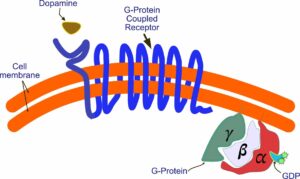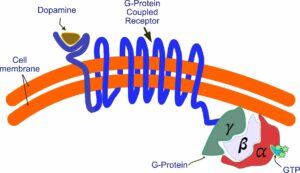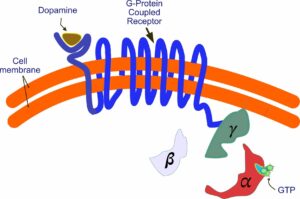7/28/24
In my last post, I wrote a little about receptors. In this one, I’ll elaborate on that discussion.
Dopamine is, among other things, a neurotransmitter and a neuromodulator. What’s the difference? Neurotransmitters allow communication between individual neurons. They are released by one neuron and travel to another across what is called a synapse, where they produce a response. Neuromodulators, on the other hand, influence many neurons at once. However, both functions require the binding of dopamine to its receptor. How does this work?

I’ve drawn a picture to illustrate the process. The figure on the right shows a simplified cartoon of a dopamine receptor. It’s the blue spring-like structure. It’s called a G protein-coupled receptor (GPCR) because it interacts with another protein, called G, located in the interior of the cell. Notice that the receptor twists snake-like around both sides of the cell membrane, with one end situated in the interior of the cell and the other in the exterior. It is in the part of the protein outside the cell where dopamine binds (agonists, which have a similar shape to dopamine, can also bind there). When it does so, it results in a change in conformation of the protein at its other end—in the interior. This change in conformation allows signals outside the cell to communicate with the contents within.
The next figure illustrates that the right-hand portion of the receptor has changed its shape due to the binding of dopamine at the other end of the molecule. This interior end interacts with the G protein, a protein consisting of three subunits: alpha, beta, and gamma. The alpha subunit has a substance called GDP (guanosine diphosphate, for those who want to know) bound to it. GDP is a small molecule with two phosphates at its end. When the receptor engages the G protein, the GDP is replaced with GTP, an energetic molecule with three phosphates bound. What happens next is shown in the next figure.
 The G protein breaks apart, releasing the alpha subunit. It now interacts with components in the interior of the cell. One such component is an enzyme called adenyl cyclase. This enzyme becomes active and begins synthesizing cyclic AMP, an important molecule that interacts with a whole series of other molecules, influencing a variety of physiological processes. This, of course, is a simplification—not the whole story by a lot. For example, there are five different dopamine receptors—D1 through D5, all of which do different things. The process itself is also more complicated than I’ve shown. You can get a more detailed picture by going to the Wikipedia entry under G protein-coupled receptors.
The G protein breaks apart, releasing the alpha subunit. It now interacts with components in the interior of the cell. One such component is an enzyme called adenyl cyclase. This enzyme becomes active and begins synthesizing cyclic AMP, an important molecule that interacts with a whole series of other molecules, influencing a variety of physiological processes. This, of course, is a simplification—not the whole story by a lot. For example, there are five different dopamine receptors—D1 through D5, all of which do different things. The process itself is also more complicated than I’ve shown. You can get a more detailed picture by going to the Wikipedia entry under G protein-coupled receptors.